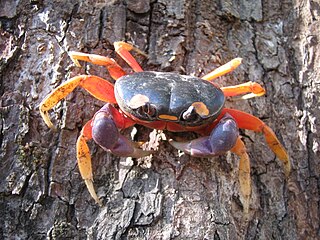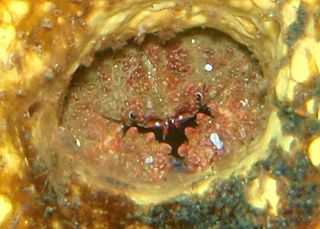The stalk-eyed mud crab, Macrophthalmus hirtipes, is a marine large-eyed crab of the family Macrophthalmidae, endemic to New Zealand including Campbell Island. It grows to around 30 millimetres (1.2 in) shell width. It is either the only species in the subgenus Hemiplax and the most basal species in the genus Macrophthalmus, or the only species in the sister genus Hemiplax.

Discoplax longipes is a species of terrestrial crab. It is found in karstic caves on Pacific islands and ranges from the Loyalty Islands to French Polynesia. Mating occurs in the caves, after which the females migrate to the sea to release their fertilised eggs. The genus Discoplax was for a long time synonymised with Cardisoma, but was resurrected in the late 20th century.

Gecarcinus is the type genus of the land crab family Gecarcinidae. They are found in warmer coastal regions of the Americas, including islands in the Caribbean. Four species from oceanic islands were formerly included in Gecarcinus as the subgenus Johngarthia, but are now treated as a separate genus, Johngarthia. While all members of this genus are largely terrestrial, they have to return to the ocean to breed. They are often colourful, with reddish, orange, purple, yellowish, whitish or blackish being the dominating hues. This has resulted in some species, notably G. quadratus and G. lateralis, gaining a level of popularity in the pet-trade.

Johngarthia is a genus of crabs in the land crab family Gecarcinidae, formerly included in the genus Gecarcinus, and containing the following five species:

Eubrachyura is a group of crustaceans comprising the more derived crabs. It is divided into two subsections, based on the position of the genital openings in the two sexes. In the Heterotremata, the openings are on the legs in the males, but on the sternum in females, while in the Thoracotremata, the openings are on the sternum in both sexes. This contrasts with the situation in other decapods, in which the genital openings are always on the legs. Heterotremata is the larger of the two groups, containing the species rich superfamilies Xanthoidea and Pilumnoidea and all the freshwater crabs. The fossil record of Eubrachyura extends back to the Cretaceous; the supposed Bathonian representative of the group, Hebertides jurassica, ultimately turned out to be Cenozoic in age.

Cheiragonidae is a small family of crabs, sometimes called helmet crabs, placed in its own superfamily, Cheriagonoidea. It comprises three extant species, Erimacrus isenbeckii, Telmessus acutidens and Telmessus cheiragonus, there are no yet evidences of Cheiragonidae in the fossil record. Many of these crabs were formerly treated as members of the Atelecyclidae.
Vultocinus anfractus is a species of crab, the only species in the family Vultocinidae. It has been found around the Philippines, Vanuatu and New Caledonia, and lives on driftwood. Its discovery forced a reappraisal of the relationships within the superfamily Goneplacoidea, and to the recognition of Mathildellidae, Conleyidae and Progeryonidae as separate families.

The Plagusiidae are a family of crabs, formerly treated as a subfamily of the family Grapsidae, but have since been considered sufficiently distinct to be a family in their own right. The family Plagusiidae includes the subfamily Plagusiinae, comprising the genera Percnon and Plagusia, which constitute a widespread group of litophilic, intertidal and subtidal crabs that are notorious for their speed and their agility.
Pseudozioidea is a superfamily of crabs, formerly treated in the Eriphioidea, Carpilioidea, Xanthoidea, Pilumnoidea and Goneplacoidea. A number of fossils from the Eocene onwards are known from the family Pseudoziidae. Eleven genera are recognised in three families:

Hemigrapsus is a genus of varunid crabs comprising thirteen species found almost exclusively in the Pacific Ocean.
Villalobosius is a genus of crabs in the family Pseudothelphusidae, containing a single species, Villalobosius lopezformenti. It lives in the northern part of the state of Oaxaca, Mexico, on the Isthmus of Tehuantepec, and is adapted to a troglobitic lifestyle.
Karstarma is a genus of karst-dwelling crabs formerly included in Sesarmoides.
Cyrtocarcinus truncatus is a species of crab in the family Xanthidae that lives in the waters around Hawaii. It was described in 1906 by Mary J. Rathbun as Harrovia truncata, based on a single immature male specimen caught near Kauai. Masatsune Takeda transferred the species to his new genus Glyptocarcinus in 1979, and Peter Ng and Diana Chia erected a new genus, Cyrtocarcinus, for this species alone, in 1994.
Vellodius etisoides is a species of crab in the family Xanthidae. It was originally described as Pilodius etisoides, but was transferred to the monotypic genus Vellodius in 1998. It is found around Amami Ōshima in the Ryūkyū Islands, and the Paracel Islands in the South China Sea.
Demania is a genus of crabs in the family Xanthidae, containing the following species:
Euryxanthops is a genus of crabs in the family Xanthidae. It was originally established in 1983 by Garth & Kim to contain three species of deep-water crabs from Japan and the Philippines - Euryxanthops dorsiconvexus, Euryxanthops flexidentatus and Euryxanthops orientalis. Since then, several more species of this genus have been identified and described, and Euryxanthops currently contains:
Linnaeoxanthus is a genus of crab, whose only species is Linnaeoxanthus acanthomerus. Linnaeoxanthus is the only genus of the family Linnaeoxanthidae.
Hainanpotamon is a genus of freshwater crabs, containing the following species:

Pilumnoides is a genus of crabs in the family Pilumnoididae. It contains the following species:
















